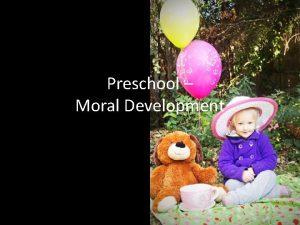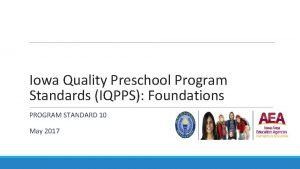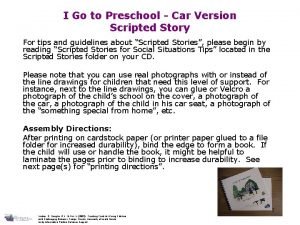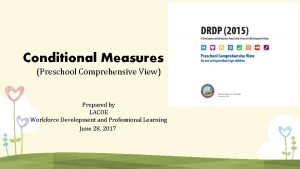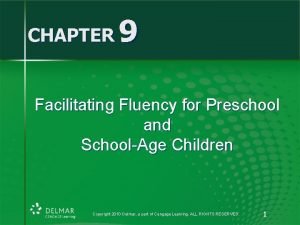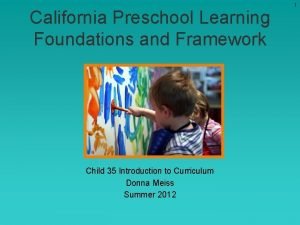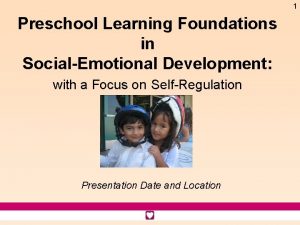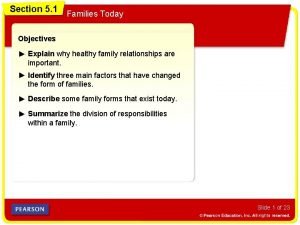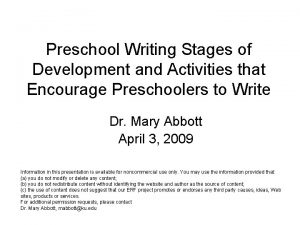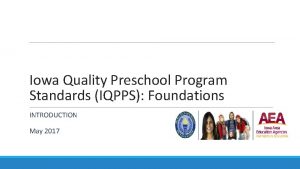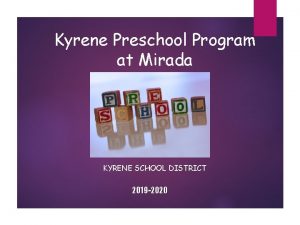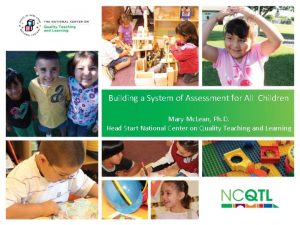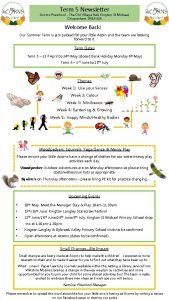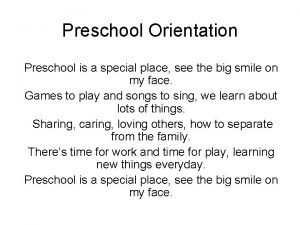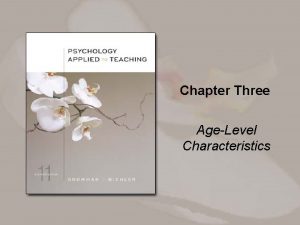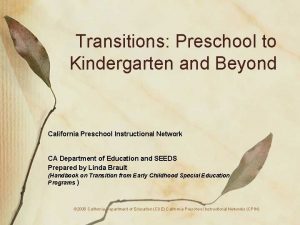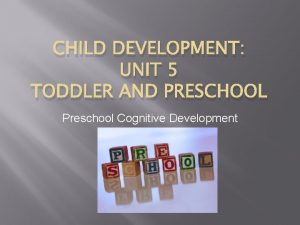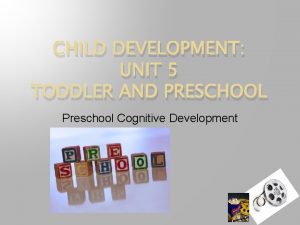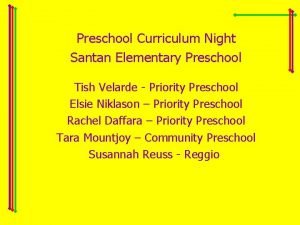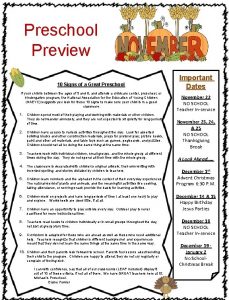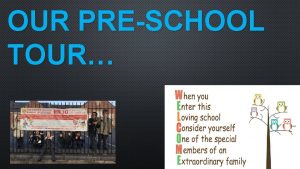AgeLevel Characteristics Unit 3 PRESCHOOL AND KINDERGARTEN 3



















































- Slides: 51

Age-Level Characteristics Unit 3

PRESCHOOL AND KINDERGARTEN 3 TO 6 YEARS Physical Characteristics 1. Preschool children are extremely active. They have a good control of their bodies and enjoy activity for its own sake. Ø Provide plenty of opportunities for the children to run, climb, and jump. Ø Total freedom for the children is dangerous. Ø Arrange things to make it easy to control. . . . .

2. Because of their tendency to be very active, kindergarteners need frequent rest periods. They often don’t realize they need to slow down. Ø Give time for quiet activities after tiring physical ones. Ø Have rest time. Ø Too much excitement may result in a riot. . . . .

3. The children’s large muscles are more developed than those that control fingers and hands. Therefore, they may be incapable of such skills as tying shoes, buttoning coats, etc. Ø Avoid too many meticulous activities such as pasting paper chain. Ø Provide big brushes, crayons, paper, and tools (king-size equipment) appropriate for children muscular development. . . . .

4. Kindergarteners cannot easily focus their eyes on small objects; therefore, their eye-hand coordination may be imperfect. Ø If possible, minimize activities to look at small objects. Ø Avoid too many meticulous activities. . . . .

5. The children’s bones that protect the brain are still soft. Ø Be alert of blows to the heads in fights between children. Ø Intervene immediately when you notice a fight using such a blow. Ø Warn the class that this is dangerous and explain why. . . . .

6. Although boys are bigger, girls are ahead of boys in all areas of development, especially in fine motor skills, so don’t be surprised if boys are clumsier at doing with small objects. Ø Avoid boy-girl comparisons or competitions involving such skills. Ø Question: Should girls start school earlier than boys? . . . . .

7. Handedness is established in most children, and more than 95% are right-handed. Ø It is unwise to force s to lefty to change. Ø Being right-handed may be more convenient, but it usually not that important. Ø Forcing a child to switch may make him feel guilty, nervous, and upset. . . . .

Social Characteristics 1. Most children have one or two best friends, but these friendship may change rapidly. v Preschoolers are flexible socially; they are willing and able to play with other children in the class. v Favorite friends are of the same sex, but many are between boys and girls. v Some children seem to lack the ability to join others or prefer to be a loner or an observer rather than a participant. v Sociograms can be used to reveal companion preferences.

2. Playgroups tend to be small and not too highly organized. v Don’t worry if children flit constantly from one activity to another; such behavior is normal for this age group. v Think about how much control you need to give to your pupils. v At what point will that behavior become a destructive behavior? . . . . .

3. Quarrels are frequent, but they tend to be of short duration and quickly forgotten. v When 30 students are thrown together for the first time in a restricted environment with a limited number of objects to be shared, quarrels are inevitable. v If you have to interfere, you might to distract the antagonists by suggesting other activities rather than acting like a referee. . . . .

4. Preschoolers enjoy dramatic play; most of the plots come from their own experiences or TV shows. v Provide simple props that fit the plot you think desirable. v What kind of dramatic play will you want to encourage---and discourage? . . . . .

5. Awareness of sex roles begins. v By the time they enter kindergarten, most children have understanding of behavior that is considered appropriate for males and females. v Some believe---but is now questioned--- that boys are depicted as active, adventurous, self-confident, and ambitious, whereas girls are depicted as homemakers. As a result, girls dutifully prepare for a role as housewife, only to discover that they want something beyond it when they grow up. . . . .

Emotional Characteristics 1. Kindergarten children tend to express their emotion freely and openly. Anger is frequent. v Most people tend to hide their feelings; but for children they would let children express their feelings openly so that they can recognize and face their emotions. v Some kindergarten teachers urge children to analyze an unacceptable behavior, by saying “Why do you think you just hit Debbie with a pencil box? ”. . . . .

2. Preschool children may have many fears, including irrational ones, because they are exposed to many new and strange situations and they possess vivid imagination. v Fears may cause difficulty later in life in the form of specific phobias or general feelings of anxiety. v For this reason, it is unwise to tease who shows fear, to force him into the feared situation, or simply ignore his fear. . . . .

v Some specific techniques include permitting the child to approach things at his own pace and in his own way; letting him observe that other children are not afraid. v Children are very much influenced by adult example. . . . .

3. Jealousy among classmates is very common at this age since kindergarten children have much affection for the teacher and actively seek approval. v It is good to spread your attention around as equitably as possible. v When you praise particular children , do it in a private or casual way. v If a child is given generous public recognition, it is natural for the other children to feel resentful. . . . .

Mental Characteristics 1. Kindergarteners are quite skillful with language. Most of them like to talk, especially in front of a group. v Providing a “sharing time” gives children a natural opportunity for talking, but many will need help in becoming good listeners. 2. Imagination and inventiveness are at a peak at this level. v Encourage your pupils as much as possible in play, storytelling, and painting. . . . .

PRIMARY GRADES 6 -9 YEARS Physical Characteristics The children are still extremely active. Because they are required to take part for the first time in the orderly classroom, energy is released in the form of nervous habits: pencil chewing, hair twirling, restlessness, etc. ü You will have to decide how much noise and activity level are permitted. ü A few teachers insist on absolute quiet; the majority of teachers allow a certain amount of moving about and talking. ü Have frequent breaks to do something.

2. Children at these grade levels still need rest periods; they become fatigued easily as a result of physical and mental activities. ü Give time for quiet activities after heavy ones or mental concentration, (e. g. story time after math; art after reading or spelling).

3. Large-muscle control is still superior to coordination. It is difficult for many children, especially boys, to hold a pencil in a correct way. Avoid requiring much writing at one time. If drill periods are too long, skill may drop and they may develop a negative attitude toward writing or school in general.

4. The eyes don’t fully accommodate until most children are about 8 years old. Consequently, may primary-grade pupils may have difficulty focusing on small prints or objects. ü Avoid requiring too much reading at one row. ü Be alert for signs of eye fatigue (e. g. , rubbing eyes, blinking). ü Have children read with large print.

5. The common illnesses of childhood may frequently happen during this age period. ü Don’t be surprised if your beautifully organized lesson plans are disrupted by frequent absences. ü Be on alert for pupils who seem to show signs of physical weaknesses; they can be isolated or sent home.

6. At this age children tend to be extreme in their physical activities. They have excellent control of their bodies and are confident in their skills, often resulting in underestimating dangers. The accident rate is a peak in the third grade. ü You might keep a first-aid book handy, but try to prevent reckless play. ü For example, during recess encourage children to participate in a relay race.

Social Characteristics 1. At this level children become somewhat selective in their choice of friends. They are likely to have a more or less permanent best friend and may also pick out a semi-permanent “enemy”. ü In the primary grades you might use sociograms to gain some insight into friendships and then give assistance to children who have difficulty in attracting friends.

2. Children at nine years old like organized games in small groups, but they may be overly concerned with rules. They find it difficult how and why rules should be adjusted to special situations.

3. Quarrels are still frequent. Words are used more often than physical aggression, but many boys still do punching, wrestling, and shoving. ü If certain children, especially the same pair, are involved in a long battle, you should try to reconcile them. ü What effective techniques for breaking up a fight can you think of?

4. Competition becomes noticeable. Boasting may be common. ü Competition is inevitable both in school and in life, and it is a desirable form of motivation. ü However, it has many negative consequences, so you have to limit comparisons and encourage the children to compete with themselves rather than with others. ü If a child feels he is competing successfully against himself, he does not ned to think he is superior. ü But if you still encounter boasting, encourage them to be gracious winners as well as good losers.

5. Boys and girls begin to show different interests, both in schoolwork and in play. The degree of sex differences varies. ü To discourage differences, do not emphasize boygirl differences. ü Allow children to choose their own desks.

Emotional Characteristics 1. Children of this age are becoming aware of the feelings of others. However, they may hurt others deeply by attacking a sensitive spot without realizing how bad their attack is. ü It sometimes happens that teasing a child who has reacted to a scold becomes a group pastime---be aware of this: prevent an escalation of teasing.

2. Primary-grade pupils are sensitive to criticism and ridicule and may have difficulty adjusting to failure. They need frequent praise and recognition. ü Because they tend to worship their teacher, young children may be crushed by criticism. ü Provide positive reinforcement as frequently as possible and hide your negative reactions for nonacademic misbehavior. ü It is important to avoid ridicule and sarcasm.

3. At this level children are eager to please the teacher. They like to help, enjoy responsibility, and want to do well in their schoolwork. ü The technique for satisfying the urge to “help” is to assign jobs (e. g. , eraser cleaner, wastebasket emptier, paper distributor, etc. ) on a rotating basis. ü Use signs of affection to show your appreciation of the work they have done by, for example, smiling, a pat on the back, a kind word, etc.

Mental Characteristics 1. Generally speaking, primary-grade pupils are eager to learn. They have built-in motivation. ü Make the most of it. 2. They like to talk and have more ability in speaking than in writing. They are eager to recite---whether they know the right answer or not. ü Control participation so that children speak up only when they are called on. ü Phrase gently and/or humorously that an answer is incorrect or irrelevant.

3. Many children experiment with vulgar language upon discovering the power of words. They know they get a reaction, although they don’t understand why. ü Probably, your first response to vulgar language should be to ignore it in the hope that it will be dropped from absence of responses. ü One effective approach is simply to say that such words are not pleasant to listen to and are not to be used.

4. Concept of right and wrong begin to develop. ü Studies of the development of ethical concepts suggest that the best way to help children at this level is to discuss specific acts as they occur, encouraging the pupils think about why an act is good or bad.

ELEMENTARY GRADES: 9 TO 12 YEARS Physical Characteristics 1. A quick growth occurs in most girls and starts in early-maturing boys. On the average, girls between the ages of eleven and fourteen are taller and heavier than boys of the same age. (Olson and Hughes, 1950) § Children in a six-grade level vary in height and weight, especially boys and girls.

If a fast-maturing girl thinks that the ideal female is petite, she may be upset about her size. How can you explain that most girls are taller?

2. Many girls reach puberty. Secondary sex characteristics begin to appear. Concern and curiosity about sex are almost universal, especially among girls. § Average of puberty for girls is 12. 5 years (in the US between 12 and 13) and for boy is 14. § Since sexual maturation involves drastic biological and psychological adjustments, children become concerned and curious.

§ It is desirable to give accurate, unemotional answers to questions about sex. § It is also good for your own protection to find out about the sex-education policy at your school; some schools forbid discussions of sex in class even on informal basis. or

§ If no restriction exists but you feel uncomfortable about leading a discussion, you might make use of films or pamphlets available, or invite a nurse or a doctor to do the explanation. 3. Fine motor coordination is quite good; therefore the manipulation of small object is easy and enjoyable for children. As a result, arts and crafts and music activities are popular. § Encouraging active participation in drawing, model making, batik painting, toys, dolls, etc. is excellent to make the most of the children’s newly developed manipulative skills. § Ideally, such activities center on originality and creativity but not on copying or assembling st.

4. Bone growth is not yet complete; therefore bones and ligament can’t stand heavy pressure. § Punching is not recommended, but rather they switch to competition involving coordinated skills. § In team games, encourage rotation of tiring positions, for example, pitching in baseball or “kasti”.

5. Boys developed very fast in strength and endurance and enjoy rough play so much that they often injure themselves. § They have the desire to demonstrate “manliness” , which may lead boys to more dangerous activities. § It is best to explain why such activities are dangerous and to encourage them to demonstrate in usual sports and games.

Social Characteristics 1. The peer group becomes powerful and begins to replace adults as the major source of behavior standards and recognition of achievement. § During the early school years, parents and teachers set standards of conduct and most children obey them. § By the end of elementary school, children may be more eager to impress their friends than to please the teacher. § Unfortunately, some boys my try to impress their classmates by ignoring the teacher.

2. The interest of boys and girls become more divergent. There may be a battle of the sexes in the form of exchange of insults, competition in schoolwork and games, etc. § Such antagonism probably results from the children’s developing recognition of the different roles assigned to boys and girls in our society. . § Boys tend to be critical of girls for a longer period of time, perhaps because girls are better off physically and scholastically. § Public comparisons and competition between boys and girls probably should be avoided.

3. Team games become more popular, and class spirit grows stronger. § Teams may dominate pupils’ free time. § What kind of elementary grade teams are you familiar with? §. . . . .

4. Hero worship is common. Sometimes the teacher is the idol; more frequently football, TV, records, and movie stars are the subjects of fans. § It may be necessary for you to cool the desire of an adoring pupil. But remember, the pupil may be serious about his or her fan and therefore ridicule or even humorous treatment of the situation is unwise.

Emotional Characteristics 1. Conflict between the group code and adult rules may cause difficulty, including juvenile delinquency. ü If you control the classroom in a fair, consistent manner, the conflicting standards of behavior usually can be avoided. ü Having children make suggestions on rules of behavior for the class is one way to achieve a compromise.

2. Children at this level are able to take soft actions and to accept the idea that rules and codes are suggestions rather than strict rules. ü Examples: Listen to the teacher when she is talking or yelling. Keep your shoes on in school. Don’t say shut up if the teacher doesn’t like it. Don’t go to the bathroom very often. Be polite to all teachers, not just yours. Be good to the little people. Etc.

Mental Characteristics 1. At the elementary level, children are curious about almost anything. ü Curiosity is an asset and should be valued. ü Encourage children to find answers themselves rather than always supplying them. ü If a child asks a question you are unable to answer, remember that bluffing is dangerous and foolish. Your pupils will not expect you to know everything, but they will lose faith in you.

2. Many children set unrealistically high standards for themselves and tend to be perfectionists. Frequently, inability to meet such standards leads to feelings of guilt and frustration. ü It is good to encourage each child to do his best, but you have to help them to start out with simple tasks and work up to difficult ones. 3. Children want to become more independent, but at the same time they both want and need adult guidance and support. This may cause disorganized, unpredictable, or inappropriate behavior. ü The only thing you can do is be as patient and understanding as possible.

The End
 Kindergarten thematic unit
Kindergarten thematic unit Saguaro infant care and preschool
Saguaro infant care and preschool Unit 10, unit 10 review tests, unit 10 general test
Unit 10, unit 10 review tests, unit 10 general test Oregon early learning and kindergarten guidelines
Oregon early learning and kindergarten guidelines Fountas and pinnell phonics kindergarten
Fountas and pinnell phonics kindergarten Drdp modified essential view
Drdp modified essential view California preschool curriculum framework volume 1
California preschool curriculum framework volume 1 Nursery school ukraine
Nursery school ukraine Preschool moral development
Preschool moral development Expulsions
Expulsions Kyrene school schedule
Kyrene school schedule Quality preschool program standards
Quality preschool program standards Scripted stories for preschool
Scripted stories for preschool Etiwanda clouds
Etiwanda clouds Drdp preschool comprehensive view
Drdp preschool comprehensive view Preschool fluency activities
Preschool fluency activities California preschool learning foundations
California preschool learning foundations Preschool learning foundations volume 1
Preschool learning foundations volume 1 Bus stop preschool
Bus stop preschool Preschool learning foundations volume 3
Preschool learning foundations volume 3 Preschool learning foundations volume 1
Preschool learning foundations volume 1 California preschool learning foundations
California preschool learning foundations Paducah head start preschool
Paducah head start preschool Kpi for preschool teachers
Kpi for preschool teachers Hippy home instruction for parents of preschool youngsters
Hippy home instruction for parents of preschool youngsters Preschool learning foundations math
Preschool learning foundations math Early childhood screening rochester mn
Early childhood screening rochester mn Clovis adults school program
Clovis adults school program Today more than half of all mothers with preschool
Today more than half of all mothers with preschool Writing stages of development
Writing stages of development Panorama heights preschool
Panorama heights preschool Hollingworth preschool
Hollingworth preschool Kyrene school district preschool
Kyrene school district preschool Kyrene school district preschool
Kyrene school district preschool Iqpps
Iqpps Preschool room arrangement
Preschool room arrangement Modbury south preschool
Modbury south preschool Ybd meaning
Ybd meaning Preschool learning foundations
Preschool learning foundations Magical thinking preschool
Magical thinking preschool Kyrene mirada
Kyrene mirada Jack in the
Jack in the Documentation boards for preschool
Documentation boards for preschool Egalia preschool sweden
Egalia preschool sweden Drdp measures at a glance
Drdp measures at a glance Preschool westlake
Preschool westlake Virginia preschool initiative income guidelines 2020
Virginia preschool initiative income guidelines 2020 June preschool newsletter
June preschool newsletter A special place preschool
A special place preschool Preschool learning foundations math
Preschool learning foundations math Preschool infrastructure
Preschool infrastructure Christ lutheran preschool avon lake
Christ lutheran preschool avon lake








